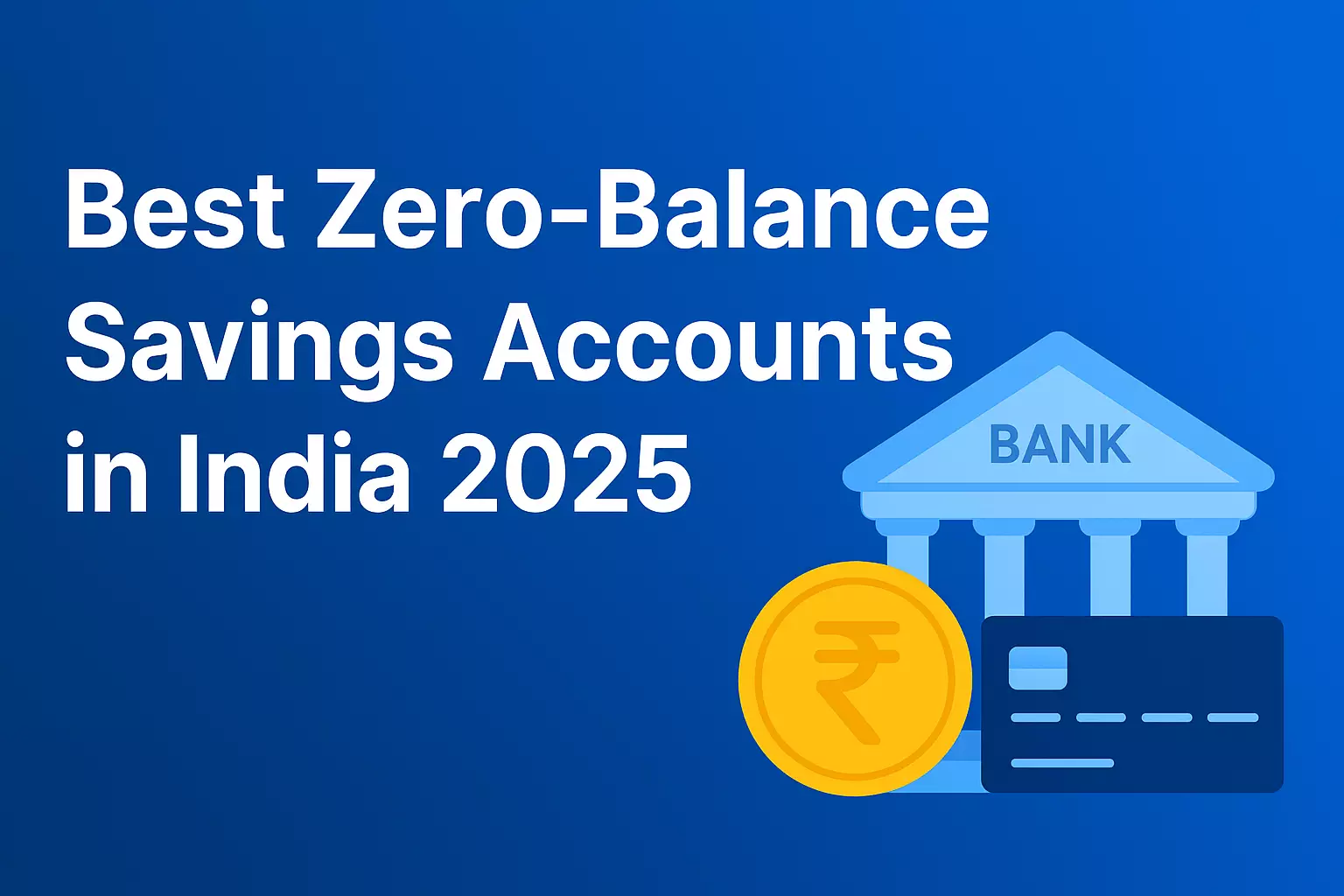Introduction
Zero-balance savings accounts have quietly become the backbone of retail banking in India. What began as a policy push for financial inclusion has matured into a diverse landscape of bank products serving students, gig workers, salaried professionals between jobs, retirees, and anyone who simply doesn’t want the stress of maintaining a minimum Monthly Average Balance (MAB). In 2025, almost every major bank—public, private, small finance, and digital-first—offers some version of a Basic Savings Bank Deposit (BSBD) Account, popularly called a zero-balance savings account. These aren’t stripped‑down compromises anymore; they are full‑service accounts with debit cards, UPI, IMPS/NEFT/RTGS, and app-first experiences.
A lot of blogs reduce this topic to a shallow table of features. That’s not what you’ll get here. This is a deep, paragraph‑rich explainer designed to help you make a confident decision. We’ll unpack how BSBD works under RBI rules, what benefits matter in real life (not just on brochures), where banks quietly place usage caps, how interest actually gets calculated, and which kind of zero‑balance account makes sense for your specific use case. By the end, you’ll have a crystal‑clear framework to pick the right account—not just the most advertised one.
What Is a Zero-Balance (BSBD) Savings Account?
A zero-balance savings account is a regulated category of savings account that does not require you to maintain a minimum balance. In RBI’s terminology, most such products are Basic Savings Bank Deposit (BSBD) accounts. The core spirit is inclusion: no one should be locked out of formal banking because they can’t keep a fixed minimum balance every month. In practical terms, a BSBD account typically includes a debit card, a passbook or e-statement option, net banking and mobile banking access, and participation in India’s retail payment rails like UPI, IMPS, NEFT, and RTGS. Some banks package this as a pure digital onboarding flow; others offer both branch-led and app-led journeys.
A common misconception is that zero balance equals zero features. In reality, banks still compete on app quality, ATM reach, UPI reliability, and soft benefits like offers or fee waivers. Where BSBD differs from a full‑featured premium savings account is not functionality but usage thresholds (for example, a limited number of free cash withdrawals) and fee philosophy (nominal, transparent charges once you exceed those thresholds). If you’re a light‑to‑moderate user or primarily digital, these thresholds rarely pinch. If you’re a heavy cash user, you need to choose a bank whose limits match your pattern.
Why Zero-Balance Accounts Exist (and Why They Matter in 2025)
Zero-balance accounts exist because banking is a utility as much as it is a business. For first-time account holders, imposing a balance requirement is a psychological and financial barrier. RBI’s BSBD framework and the government’s push through schemes like PMJDY dramatically expanded access, creating a baseline assurance: you can bank without fear of penalties. In 2025, they matter even more for three reasons. First, India’s retail payments are overwhelmingly digital—UPI has made even small-value transactions frictionless—so a functional low‑cost account is essential. Second, the nature of income is increasingly variable, from gig work to seasonal earnings, making balance‑linked penalties feel punitive and outdated. Third, banks have learned to serve these customers profitably through digital operations, partnerships, and cross‑sell, which means features keep improving while costs remain low for you.
How Zero-Balance Accounts Actually Work (Under the Hood)
The headline promise is “no minimum balance”. Under the hood, your account is still a standard savings ledger that accrues interest on daily end‑of‑day balances and pays it out at bank‑specified intervals. You typically receive a debit card (often RuPay for domestic acceptance, sometimes Visa/Mastercard for broader e‑commerce use), and you’re onboarded to the bank’s app and internet banking. Where BSBD gets specific is in free usage slabs—for example, a fixed number of free ATM withdrawals at other‑bank ATMs, a monthly quota of free cash deposits/withdrawals at branches, or zero‑fee NEFT/RTGS up to generous limits. Once you cross the slab, nominal fees kick in. This keeps the account viable while still letting ordinary users bank freely most of the time.
Importantly, BSBD does not mean you’re barred from add‑ons. Many banks let you attach standing instructions, auto‑pay mandates, UPI autopay, and e-commerce tokenization. Some offer locker discounts, card-linked offers, and in‑app goal‑based saving. What you don’t get are premium perks like lounge access or high-limit insurance bundled by default, though paid upgrades are increasingly common.
Benefits of Zero-Balance Savings Accounts (Explained in Real Life)
🔸 No Minimum Balance Requirement—Freedom from Penalties
For countless customers, this is the game‑changer. A regular savings account can penalize you for dipping below the MAB even if you had a temporary cash crunch. A zero‑balance account removes this anxiety completely. Think of a freelancer whose income hits in batches, or a student living on variable allowance—your balance may swing wildly. With BSBD, swings are fine; you won’t wake up to penalty SMSes for “non‑maintenance”. This not only saves money but also encourages you to use the account actively rather than parking funds elsewhere out of fear.
🔸 Access to Full-Stack Digital Payments Without Extra Costs
The value of a bank account today is less about a branch nearby and more about whether every QR scan, every UPI collect, and every IMPS transfer just works. Zero‑balance accounts give you UPI, IMPS, NEFT, and RTGS, plus net banking and a mobile app. For daily life, that means sending rent instantly, splitting bills with friends, topping up FASTag, and paying merchants across India with zero friction. The bigger your bank’s tech stack and uptime, the smoother this feels; that’s where picking the right bank matters more than the label “zero balance”.
🔸 Safer Than Cash—And Better for Building a Financial Trail
Holding cash is risky and invisible: if it’s lost, it’s gone, and it builds no history. Money moving through your bank account creates a transaction trail that helps with future goals—think credit cards, small business loans, or even visa applications where financial history matters. A zero‑balance account starts that trail with minimal friction. Because you can keep the balance at any level, you won’t artificially change your behavior just to dodge fees; your genuine spending and saving pattern shows up in statements that lenders respect.
🔸 Direct Benefit Transfer (DBT) & Government Scheme Compatibility
From LPG subsidies to scholarships and social security benefits, DBT puts money directly into beneficiaries’ accounts. Zero‑balance accounts are typically DBT‑ready out of the box and, in PMJDY’s case, intentionally designed for it. This matters if you or your dependents receive any government benefit: funds arrive faster, leakages are minimized, and you can track receipts on your phone instead of chasing paperwork.
🔸 Transparent, Predictable Fees (Only After Free Slabs)
People don’t mind paying small, fair fees; they hate surprises. BSBD’s design sets transparent slabs: X free ATM withdrawals, Y free cash transactions, Z free cheque leaves. If you’re mostly digital, you may never hit the paid tier. If you are cash‑heavy, at least you can plan for it. This predictability helps you budget realistically compared to premium accounts that promise bells and whistles you may never use yet penalize you heavily for missing MAB requirements.
Interest Rates: How They’re Calculated and What They Mean
Banks publish savings interest in slabs (e.g., up to ₹1 lakh, ₹1–10 lakh, and so on). The daily product method means each day’s closing balance is multiplied by the applicable rate and summed for the period; interest is then credited monthly or quarterly depending on the bank. Two implications follow. First, timing inflows can marginally improve returns—salary credited earlier in the month accrues more days of interest than if you transfer it out on Day 1. Second, “headline” rates often apply only to specific slabs; your effective yield is a blend if your balance crosses tiers.
What should a zero‑balance user optimize for—rate or experience? If you consistently keep a large balance, chasing a higher rate at a reliable small finance or digital‑first bank can be worthwhile. If your balance fluctuates near zero and you live on UPI, app quality and uptime will matter more than a 0.5% rate delta. A practical approach is to pair a high‑yield account for idle funds with a robust, zero‑balance transactor for everyday flows.
Charges, Limits, and the Fine Print You Should Actually Read
Every BSBD account comes with free slabs and post‑slab fees. The most common limits include: number of free ATM withdrawals at other‑bank ATMs, number of free cash deposits/withdrawals at the home branch, and free cheque leaves per year. Some banks cap total monthly transactions to keep servicing costs low. None of these are hidden; they’re in the schedule of charges. The trick is aligning your usage: if you often withdraw cash at non‑home locations, pick a bank with a large own‑ATM network or generous other‑bank ATM slabs. If you deposit cash frequently (e.g., a small business owner), verify branch cash deposit limits and per‑transaction caps. If you’re fully digital, these constraints are largely irrelevant—UPI and IMPS are usually unlimited and free.
Also check card type. A RuPay Domestic card is perfect for Indian POS/UPI‑on‑card use. If you often transact on international e‑commerce sites, you may prefer a bank that issues an international Visa/Mastercard variant even in the zero‑balance category (some do, sometimes as an optional paid upgrade). Finally, glance at dispute resolution flows in the app—raise‑chargeback, hotlist card, and 24×7 chat—because when things go wrong, responsiveness trumps every brochure feature.
Bank-by-Bank Deep Dive (2025)
Below we discuss popular zero‑balance offerings the way a real user experiences them: onboarding, day‑to‑day usability, network reach, and any notable constraints. Always confirm current charges on the bank’s official page before applying, as pricing evolves.
State Bank of India (SBI) – Basic Savings Bank Deposit Account
SBI’s BSBD is the definition of ubiquitous. Onboarding is straightforward at branches and supported digitally for many profiles. You get a debit card, passbook, and strong compatibility with DBT. The biggest practical benefit is ATM and branch reach—SBI’s footprint means you’re rarely far from access. Typical slabs include unlimited withdrawals at SBI ATMs and a limited number of free transactions at other‑bank ATMs. The mobile app (YONO) has improved, and UPI rails are robust. If your priority is nationwide access and you or family members rely on DBT, SBI remains a safe, predictable choice.
HDFC Bank – Basic Savings Bank Deposit Account
HDFC’s BSBD wraps a polished digital experience around a compliant zero‑balance core. You generally get a RuPay card, a cheque book, and full app/internet banking. The value here is reliability: HDFC’s UPI, IMPS, and net banking stacks are mature, and the app UI is among the best in class. If you live in a metro or tier‑1 city and want a premium‑feeling experience without worrying about MAB, HDFC’s BSBD is a great fit. Watch the free‑transaction slabs for cash at branch and other‑bank ATMs if you’re cash‑heavy.
Axis Bank – Basic Savings Account
Axis offers a balanced package with a RuPay card and generous digital transfers. The mobile app is modern, and customer communication is transparent. Four free other‑bank ATM transactions per month is common across the industry; Axis adheres to that baseline while offering solid own‑ATM reach in urban centers. For users who split life between cashless payments and occasional cash pickups, Axis keeps the experience smooth without surprise fees.
ICICI Bank – Zero-Balance Variant
ICICI’s strength is network and tech stability. With access to a very large ATM network and a consistently reliable UPI/IMPS backbone, it’s an easy recommendation if you move around and need dependable access everywhere. Onboarding is fast, app flows are intuitive, and tokenization for cards is smooth for frequent online shoppers. Expect a standard set of free slabs and, beyond that, nominal charges clearly disclosed in the schedule.
Kotak Mahindra Bank – 811 (Digital)
Kotak 811 pioneered instant digital savings in India and continues to refine the experience. You can open the account with Aadhaar‑based e‑KYC, start transacting quickly with a virtual debit card, then opt for a physical card. The value proposition is speed and app‑first design—scan‑and‑pay, set UPI handles, create virtual cards for safer online transactions, and manage limits in‑app. If you’re primarily digital and rarely visit branches, 811 is purpose‑built for you. Review upgrade paths (811 variants) if you want higher transaction limits or international card features.
IndusInd Bank – Zero Balance/Indus Small Savings
IndusInd positions its zero‑balance product as feature‑rich with a focus on convenience: debit card, passbook, cheque book, NEFT/RTGS, and usually a handful of free cash transactions. The app has steadily improved, and UPI performance is solid. Where IndusInd shines is responsiveness—branch staff and phone support are generally helpful, which matters if you’re transitioning from cash‑only to digital and need guidance occasionally.
RBL Bank – Digital Savings
RBL leans into higher savings rates and a digital‑friendly proposition. If you maintain a non‑trivial balance at times, the yield can be attractive relative to large incumbents. The app focuses on clean flows for UPI and fund transfers, and the bank is transparent about free slabs. There may be KYC completion steps (like specimen signature) after a period; complete those on time to avoid friction. For rate‑seekers who still want a nimble app, RBL is worth a look.
IDFC FIRST Bank – Pratham/Zero-Balance Variant
IDFC FIRST competes on experience and rates, often offering higher slabs for everyday balances. Internet and mobile banking are strong, and customer service is attentive. Cheque book, passbook, and debit card are typically included. If you’re the kind of user who keeps 1–2 lakh idle for short spans, your effective return can be meaningfully better here without compromising on app quality.
YES Bank – Zero-Balance
YES Bank’s zero‑balance account highlights seamless digital transfers (NEFT/RTGS free in many configurations) and sometimes includes premium‑feeling card variants like an International Platinum Chip Card. For card‑centric users who pay online frequently and appreciate detailed spend analytics in the app, YES provides a feature‑forward mix. As with others, check the post‑slab cash transaction fees if you rely on branches.
DBS – digibank (Digital Only)
DBS digibank is fully paperless with fast onboarding, a clean app, and a strong reputation for digital stability. Unlimited digital transactions, free cheque books, and a straightforward debit card offering make it appealing to urban users who rarely interact with branches. If you want minimal friction and value clean, reliable UX, digibank fits perfectly.
Standard Chartered – Basic Banking Account
SC offers a BSBD aligned to its global‑bank polish: a good internet banking experience, often an international debit card variant, and clean documentation. If you travel, transact internationally online, or simply prefer foreign‑bank app aesthetics, SC’s basic account can be a comfortable home base. Do verify currency markup and international transaction enablement if you plan to use the card abroad.
AU Small Finance Bank & Utkarsh Small Finance Bank
Both AU and Utkarsh are strong on deposit rates and increasingly competitive on app design. If you live in their footprint or prefer higher yields on idle balances, these banks are compelling additions to your mix. BSBD variants usually preserve the zero‑balance promise while letting you enjoy modern digital features. Always review ATM network access in your city to avoid depending on other‑bank ATMs for every cash withdrawal.
Documents & Onboarding—Getting From “I Want One” to “It’s Live”
KYC remains straightforward. The most common identity documents are Aadhaar, PAN, Passport, Voter ID, Driving Licence, and NREGA job card. For digital‑first accounts like Kotak 811 or DBS digibank, Aadhaar‑based e‑KYC can complete the process end‑to‑end from your phone, sometimes followed by a video‑KYC or in‑person verification if needed for higher limits. A practical tip: keep PAN handy to avoid TDS complications on interest and to enable investment features later (FDs, mutual funds, or UPI autopay mandates). If you’re opening for a senior family member, consider branch‑led onboarding to issue a physical passbook immediately and help them set up SMS alerts so they’re always in the loop.
PMJDY vs Bank-Offered Zero-Balance Accounts—Same Shape, Different Superpowers
PMJDY (Pradhan Mantri Jan Dhan Yojana) accounts are the iconic inclusion vehicle launched in 2014. Like BSBD, they require no minimum balance and include a RuPay card. Where PMJDY differs is its deep integration with welfare. DBT is the norm, accident insurance is bundled (subject to conditions), and an overdraft facility becomes available after satisfactory operation for six months. For households receiving government benefits or those newly entering formal finance, PMJDY is the most straightforward on‑ramp. Bank‑offered BSBDs, on the other hand, may offer slicker apps, broader card variants, and smoother upgrade paths to premium products. Choose PMJDY if welfare linkages and branch support are priority; pick a bank BSBD if you want cutting‑edge digital UX and product upgrades later.
Who Should Open a Zero-Balance Account (And Which One)?
🔸 Students and First-Time Earners
If you’re managing pocket money, stipends, or early freelance gigs, a zero‑balance account lets you focus on building habits—saving small sums, paying digitally, and tracking expenses—without worrying about penalties. Prioritize a bank with a great app (category insights, UPI reliability, bill reminders) and decent own‑ATM reach near your campus or PG. Kotak 811, DBS digibank, HDFC BSBD, and ICICI’s zero‑balance variant are strong starting points.
🔸 Gig Workers and Freelancers With Variable Income
Your cash flows are lumpy—some months overflow, others are lean. The right BSBD absorbs this volatility. Look for instant payments (IMPS 24×7), easy inward transfers, and robust UPI. Set up a simple rule: when a big payout hits, sweep excess funds to a short‑term FD or a higher‑yield savings bucket within the same bank/app, then pull back when needed. IDFC FIRST, RBL, and AU SFB shine for yield; ICICI, HDFC, and Kotak excel for reliability and app polish.
🔸 Salaried Users Who Hate Penalties
If your employer doesn’t offer a salary account or you want a personal transactor, a zero‑balance account keeps things clean—no MAB, no nagging SMSes. Pair it with automated bill payments and UPI autopay. Consider SBI for nationwide cash access, HDFC/ICICI for premium digital UX, or Axis for a balanced, urban‑friendly mix. If you maintain buffers, IDFC FIRST and AU SFB can add yield.
🔸 Retirees and Caregivers Managing Family Finances
Predictability and service matter more than flash. Choose a bank with friendly branch staff, easy passbook updates, and strong SMS alerts. SBI and IndusInd are excellent for branch comfort; HDFC for app clarity if family members assist remotely. Enable nominee details immediately and keep a laminated card with account and helpline info for emergencies.
🔸 Small Merchants and Cash-Heavy Users
Zero‑balance is viable even if you handle cash daily—just choose a bank with generous free cash deposit/withdraw slabs or a nearby branch you trust. Pair the account with a UPI QR to nudge more customers to pay digitally and reduce cash handling over time. Axis, SBI, and IndusInd are pragmatic choices for their branch networks and service reliability.
How to Choose (A Simple, Bulletproof Framework)
🔸 Start With Your Primary Channel (App vs Branch)
If you’re 90% app‑driven, judge banks by app stability, UPI uptime, and in‑app controls (limits, card hotlisting, dispute flows). If you’re branch‑heavy, ATM proximity and staff support trump everything. Your daily friction will come from the channel you use most—optimize for that, not for a marginally higher interest rate.
🔸 Map Your Cash Habits to Free Slabs
Write down how many times a month you withdraw cash, deposit cash, and use other‑bank ATMs. Now match that against each bank’s BSBD slabs. If you’ll constantly exceed limits, either pick a bank with more generous slabs or plan to go mostly digital. The best account is the one that avoids nickel‑and‑diming your specific pattern.
🔸 Decide If Yield Matters (And Park Idle Money Strategically)
If you routinely keep ₹50,000–₹2,00,000 idle, yield matters. Consider IDFC FIRST, AU SFB, RBL, or Utkarsh for better rates. If your balance hovers near zero, prioritize reliability over yield. You can also run a two‑account strategy: one high‑yield bucket for parking, one best‑in‑class transactor for daily use.
🔸 Check Card Rails and International Needs
If your life includes international online purchases or travel, confirm whether the bank issues an international card on the zero‑balance tier (some do) or allows an inexpensive upgrade. If not, you can always keep a secondary carded account for cross‑border needs while using BSBD for domestic flows.
Common Pitfalls (And How to Avoid Them)
🔸 Ignoring KYC Completion Windows
Some digital accounts open under simplified KYC with lower limits and require full KYC later (video/in‑person). Miss the window and your limits can shrink temporarily. Put a reminder to finish KYC as soon as possible so your account operates at full capacity.
🔸 Forgetting That “Free” Has Slabs
Four free other‑bank ATM withdrawals per month is an industry norm; after that, fees apply. If you rely on cash, this will sting if your bank has thin ATM coverage nearby. Solve this by using your bank’s own ATMs where withdrawals are often unlimited or by planning fewer, larger withdrawals.
🔸 Mixing DBT and High-Value Transacting Without Planning
If your account receives government benefits, be mindful of how you mix personal large inflows/outflows if you also want to keep the account primarily for benefits. It’s often cleaner to separate a DBT‑focused account (PMJDY) from a heavy‑use digital transactor, so reconciliations are effortless and statements stay simple.
FAQs
Can NRIs open zero-balance digital accounts?
Many banks offer NRE/NRO digital onboarding, but BSBD is primarily designed for resident customers. Some banks do offer zero‑balance‑like digital accounts to NRIs after full KYC and regulatory checks. Always confirm eligibility and documentary requirements; if unavailable, consider a standard NRE/NRO savings product with low MAB or fee waivers tied to relationship value.
Is joint holding allowed?
Yes. Most banks allow joint BSBD accounts, typically among close family members. Joint mode is useful if an elderly parent needs help operating the account—set “Either or Survivor” for flexibility and ensure both holders have app access (or at least SMS alerts) configured correctly.
Can I convert my regular savings to BSBD?
Banks often prefer BSBD for new‑to‑bank customers, but some will allow conversion. The trade‑off is that premium features bundled with your existing account may be withdrawn. If your goal is simply to avoid MAB penalties, compare whether switching to a low‑MAB or salary variant preserves features you value while solving the fee pain.
What happens if I don’t use the account?
If there are no customer‑initiated transactions for a specified period, the account may become dormant. You can reactivate with a simple request and fresh KYC if needed. Keep the account alive by making a small UPI, IMPS, or card transaction every few months—set a reminder so you never lose access at the wrong moment.
Can I hold multiple BSBD accounts at the same bank?
No. RBI permits only one BSBD per bank. You can, however, maintain BSBD accounts at different banks if that suits your lifestyle (e.g., one near your hometown branch network and one digital‑first account for daily UPI).
How do banks sustain zero-balance economics?
Digital onboarding, standardized feature sets, and cross‑sell make BSBD viable. Banks earn float income on balances, interchange on card transactions, and fees beyond free slabs—without penalizing ordinary usage. This is why choosing a bank whose app you actually enjoy using makes a difference: the better the UX, the more you use it, and the more value both sides realize.
Conclusion: The Practical Playbook
Pick your zero‑balance account by channel fit (app vs branch), match your cash habits to free slabs, and decide whether yield matters for your typical idle balance. If you want the comfort of a vast network and DBT readiness, SBI is evergreen. If you want polished apps and bulletproof digital flows, HDFC, ICICI, and Kotak 811 are standouts. If your balance sometimes sits higher and you want better yield without losing modern UX, IDFC FIRST, AU Small Finance Bank, RBL, and Utkarsh deserve a close look. You can even run a two‑account setup: one high‑yield park, one rock‑solid transactor. Either way, BSBD has done its job—you bank on your terms, with zero fear of balance penalties.




